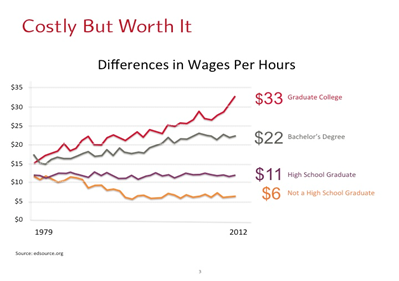Last month, as I was preparing to give a commencement address to the 2016 graduates of Columbia University’s School of Professional Studies, I found myself reflecting on the challenges and importance of completing their studies.
My mother was the first in her family to graduate from college, and although my father never went to college himself, both of my parents valued education immensely and instilled in me a similar passion for learning. They were voracious readers, spirited debaters and always doers, and they made sure their children went to school and studied hard. My own education, at my high school in London and then at Oxford and Stanford Universities, changed my life.
When I graduated, it was a big step for me and my career. But now, years later, I think about the significance not graduating has for students and for America.
Investing in yourself
College remains, for those who graduate, the best possible investment! As the accompanying chart shows, the hourly earnings wage gap continues to widen over time between those with less education and those with more [EdSource].

But earning money is only one easily observed benefit of a college degree. Overall, college graduates are less likely to be unemployed [U.S. Bureau of Labor Statistics], they are more likely to vote [The College Board], and they report having better mental health [Gallup].
So, given the advantages, why is there still debate about the return on investing in a college degree?
Well, just 53 percent of students graduate from a four-year college within six years. For two-year public institutions, the completion rate is even worse – just 38 percent. In light of these disappointing completion rates, why is so much of the focus on increasing access to higher education when the real story is that too many students don’t make it through?
And of course, many of those who fail to graduate suffer the burden of carrying debt and having no credential or enhanced earning power. They are actually punished for failing to graduate and we know that the default rate in this group is a staggering 17 percent.
I’d like to shift the conversation to how we might best ensure students graduate. Only once we’ve established better ways to graduate our students should we turn our full attention to expanding their numbers.
One pace does not fit all. And that’s okay.
We all start with a different base of knowledge, and it’s never been optimal to have one-size-fits-all classes. Given that today’s college students come from increasingly diverse backgrounds, and considering the general lack of uniformity in what level of education a high school diploma really reflects, it is ever more important that we help students – and the faculty who are so critical to their success – optimize learning at an individual level.
There are significant challenges to overcome. Shockingly, over half of the students at two-year schools (and 20 percent of the students entering four-year undergraduate programs) need some sort of remediation right from the start - at an estimated cost of nearly $7 billion a year – merely to try to make good the deficiencies of the K12 system. Unfortunately, 80 percent of these students don’t successfully complete their remediation. This is a devastating outcome for students, but also for colleges and the country – it creates unnecessary churn for the colleges and forces them into patterns of recruiting new students to replace the ones who drop out.
Thankfully, there are solutions. Personalized instruction (in the form of tutoring, for example) has long been understood to be one of the most effective learning formats, and technology has increasingly helped to make personalized instruction more widely available.
Our own studies show that students using technologies designed to personalize the learning experience get better grades and have greater success completing their courses. And instructors spend a whole lot less time on administrative tasks and more time on active learning experiences. For students taking remedial courses, these technologies can help them catch up with their peers and get back on track to an on-time degree. When you factor in the cost of tuition and increased earning potential of college graduates, it becomes clear that these outcomes can change lives.
When software is capable of personalizing a student’s learning path we call it “adaptive.” Adaptive study tools continuously assess students’ skills and knowledge, track the topics students have mastered and those that still require further practice, and adjust content along the way for each student. By zeroing in on highly actionable data – we call it “small data” – adaptive tools support not only students but their instructors, helping to identify specific problems as they arise and allowing educators to intervene early and effectively. Why wait for that failed mid-term to alert the instructor when the software can support effective intervention from day one?
Graduation matters
So at this time of year, when students don their caps and gowns and pick up their diplomas, let’s reflect on what it means not only to them but to all of us. And let’s strive to help others cross the stage and have richer and fuller lives.
